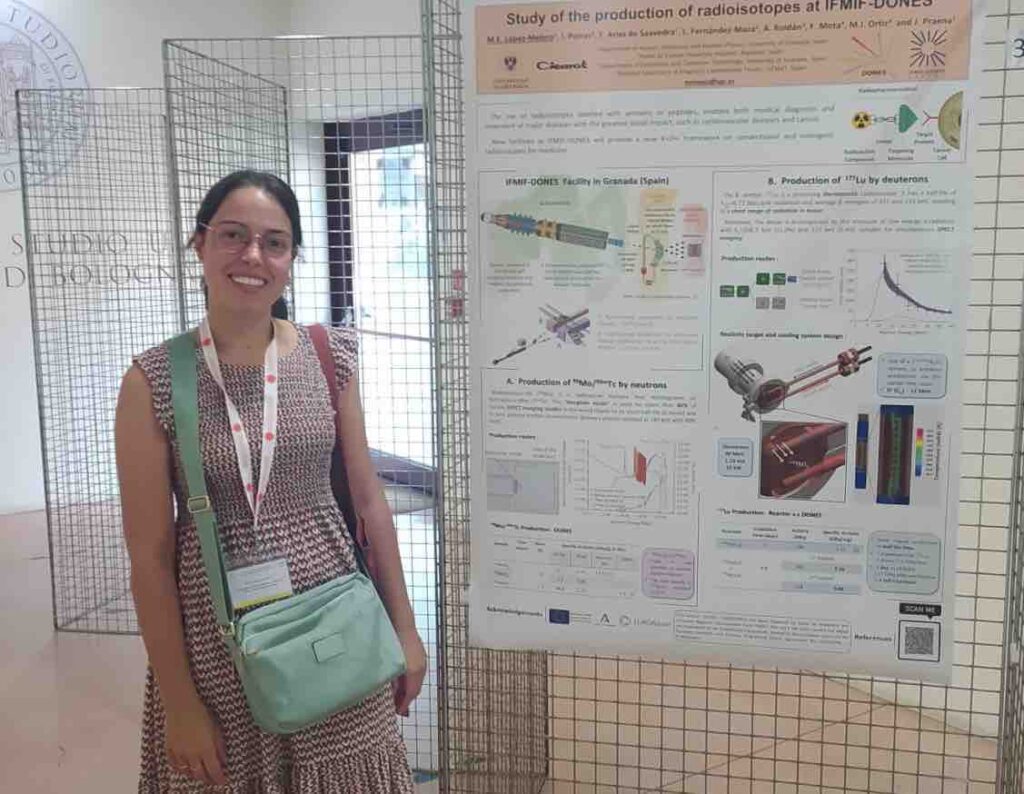IFMIF-DONES could supply Spanish hospitals with radiopharmaceuticals
Posted on |

The Atomic and Nuclear Structure group of the University of Granada (UGR), in collaboration with researchers from CIEMAT, has recently published a paper demonstrating that IFMIF-DONES could supply Spanish hospitals with the most widely used radioisotope in the diagnosis of diseases: molybdenum-technetium. Moreover, this could be done without interfering with the normal operation of the facility.
Researcher Elena López Melero, who is working on her doctoral thesis on the use of IFMIF-DONES for nuclear medicine for diagnosis and therapy, says, “We are studying a different reaction to the conventional one used in the nuclear reactors that supply our hospitals today. This production route is only accessible in facilities with a high neutron energy flux, such as IFMIF DONES. In this way, we boost secondary applications originating in this facility, such as the production of radiopharmaceuticals for our hospitals, regardless of the closure or de-supply of nuclear power plants”.
Javier Praena, professor at the UGR and director of López’s thesis, adds that “the objective is to use the surplus neutrons for medical applications. This work on the most widely used radioisotope in the world demonstrates the possibilities of IFMIF-DONES to generate R&D&I in nuclear medicine, thus contributing to the facility’s sustainability. We expect to publish the first studies on radioisotopes dedicated to therapy soon.
Molybdenum-technetium is used in more than 80% of clinical diagnostic imaging tests for oncological and neuronal diseases but is only produced in six nuclear reactors worldwide, none of them located in Spain. In fact, all of the nuclear medicine used in Spanish hospitals comes from a reactor located in the Netherlands. To this end, between one and two Molybdenum-Tecnetium generators are supplied to each hospital weekly.
After production, transport and reception at the hospitals, the radioactive molybdenum (Mo99) disintegrates into radioactive technetium (Tc99m). This, having properties different from Mo-99, is chemically separated at the health care facilities to produce the Tc-99m radiopharmaceuticals, which are then delivered to the patient. The radiation emitted by Tc-99m makes it possible to diagnose diseases such as cancer by imaging without side effects on the patient. Since the global crisis in the supply of molybdenum-technetium in 2009, there have been numerous studies to find alternative methods and facilities for its production.
Bibliographical references:
Elena López-Melero, Fernando Mota, Maria Isabel Ortiz, Fernando Arias de Saavedra, Ignacio Porras, Laura Fernández-Maza and Javier Praena*. Production of 99Mo at IFMIF-DONES reusing the flux of neutrons. Nuclear Materials and Energy, 2024, vol. 38, p. 101575. https://doi.org/10.1016/j.nme.2023.101575
On the global Molybdenum-Tecnetium supply crisis in 2008-2009, see reference, Gould, P. Europe’s isotope shortage will continue into 2009. Nature (2008). https://doi.org/10.1038/news.2008.1186
Source: UGR Channel
Photo: Elena López Melero, during the presentation of a scientific poster on her research at IFMIF-DONES.